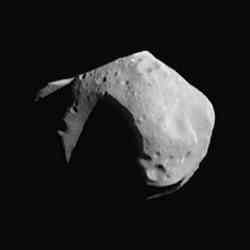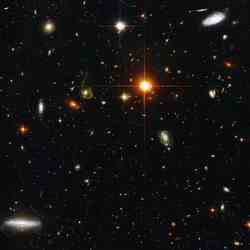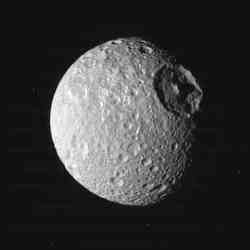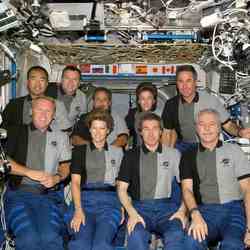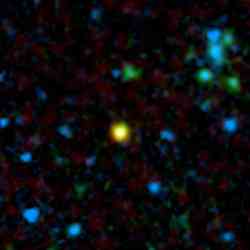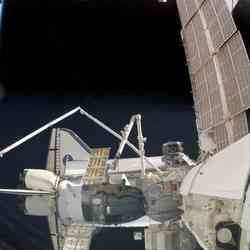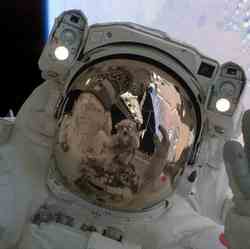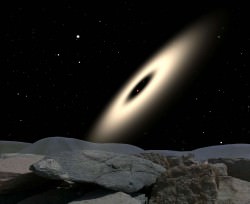
Artist’s conception of the 25-million-year-old protoplanetary disk. Credit: David A, Aguilar (CfA). Click to enlarge
Listen to the interview: Planetary Disk That Refuses to Grow Up (6 MB)
Or subscribe to the Podcast: universetoday.com/audio.xml
Fraser Cain: You’ve found the oldest planetary disk. Can you give me a sense of how unusual this is?
Lee Hartmann: This is about the oldest planetary or protoplanetary disk. The oldest one we’ve found before was something like 10 million years old, so this is about 2 to 2.5 times as old as anything we’ve found before.
Fraser: Was that a big surprise to find something that old?
Hartmann: Yeah, it seems like half or more of stars have some kind of extended dusty disk with something that would make planets. At an age of about a million years or so. And then by 10 million years or so, you’re down to like 10% of all stars or maybe even less than that. So to find this thing at twice the age was really pretty remarkable. We thought that by 20 million years we’d really be down to zero for anything that still had dust around it that was very much like a planetary disk.
Fraser: What could keep the disk stable for so long?
Hartmann: It’s not really clear. The central system in this case is actually a close binary star and so it’s possible – unlike a single star in our solar system – there are two, almost equal mass stars that are orbiting around in a very close orbit and although something the size of somewhere between Mercury’s orbit and Venus’ orbit; something that size. That could be kind of churning things up because each star has its own gravity, and as they move around they could be churning up the disk and agitating the particles. What we think happens to make planets is that the dust, the little dust bunnies, kind of stick electrostatically into small little lumps and then it grows bigger and bigger. And it makes rocks, and then it makes things that are more like asteroids, and finally planets. And the planet forming stage is what really clears out all this dust. And so that process is thought to be very delicate and things kind of settle down over timescales of thousands to millions of years. It’s possible that if you’re churning it up a little bit, keeping the particle suspended then they don’t really stick together that well and don’t go through the rest of the planetary formation process like most other stars do.
Fraser: How common would something like this be? Since this is the oldest one that’s been found, do you think that there are others nearby, or is this just a total fluke?
Hartmann: It’s hard to imagine that there’s only one of these things in the galaxy, let alone the entire Universe. But, this must be a very rare occurrence as far as we can tell. We can see large clusters of stars that are 30 million years old, 50 million years old, 100 million years old, and they haven’t found anything like this in several hundreds or even thousands of stars in total. It’s probably 1 in 1000, maybe, or something like that. That’s sort of what I would guess, but it’s hard to know. We haven’t looked carefully enough at these things. We haven’t been able to until very recently. The Spitzer space telescope has just so much more sensitivity than anything else we were able to do before. It’s just made factors of hundreds of thousands of times our ability to detect faint sources like this thing is. We’re just taking the first baby steps to explore what’s out there and in our own neighbourhood. With the Spitzer telescope, they start looking at some of these other clusters, they’re confirming that twice the age of this system, less than 1 in 1000 is like that. It’s really a fairly unique system. We must have caught it in some special circumstances.
Fraser: Do you think that it could go on for millions and millions of years more. Is this still an early age for it?
Hartmann: This is something that we don’t understand very well. And one of the reasons to study these kinds of systems is that we really need a lot of help in understanding the physics of this. The physics of how planets form out of basically dust bunnies to start with. It’s just such a complicated process, and there are all kinds of things that we don’t quite understand that we really need to have more surveys of these things. I don’t really know what’s going to happen with this system. My own opinion is that it’s probably not going to go on and coagulate into planets if it hasn’t done it already. The theory suggests that there’s kind of a threshold that you have to meet. You have to have just enough stuff to make it happen, to really get over the hump of making larger bodies which can then sweep up all the smaller dust and clear out the disk. If you don’t ever get to that threshold, you might not ever make any planets. My guess is that it might just peter out, and some of the dust grains will either get blown out or spiral in slowly into the star and that’s the end of it, but we don’t really understand.
Fraser: Have planet forming disks been seen around binary systems before?
Hartmann: Yes, if I can just qualify to say that we’re assuming these disks make planets. We haven’t really had the complete smoking gun to say that these dusty disks actually make planets. I think it’s a very strong likelihood because we see all this distributed dust around very young stars and then it’s all gone. We know that we have to coagulate all the dust and get the small stuff and put it into big things to make planets. So that’s the assumption we’re making, but I just wanted to say that we haven’t actually connected the dots on that issue.
Fraser: Right, so have disks been seen around binary systems like this?
Hartmann: Yes, they have. This issue is that basically, you can’t have the disk at the same size orbit as the binary orbit. The other star will just swallow up all the dust, or evaporate it, or blow it away. On the other hand, if you have a very wide binary, if you have something where the other star is very far way, you can have a disk well inside that binary and it doesn’t know there’s another star orbiting around. We orbit around the Sun, and Jupiter is out there at several astronomical units, and that only makes small perturbations on the orbit of the Earth. Similarly, you could have a system in which the two stars are relatively close together and the disk is well outside the outlying area. And so, to that disk, it almost looks like there’s a single star. It’s not exactly like that because the two stars are orbiting around so the gravity is churning it up a little. But it’s not that far away from just having a single object. So as long as the disk is either a lot bigger than the binary, or smaller than the binary, you’re okay. If the disk is a lot bigger than the binary, though, it can be so tenuous, and so spread out that it never really coagulates effectively into planets. That’s something we would kind of predict, but that’s not something that we’re able to demonstrate observationally yet.
Fraser: Do you have some follow on observations planned for this?
Hartmann: What I think we would like to try and do is to get longer wavelength observations to see where the disk ends, because in this set of observations, we’re basically saying that there is a disk, but we don’t know how big it is. The question is, is there anything outside this system that could be perturbing the disk as well. It might even be a triple system for all we know, with a very much wider companion that is low mass and we haven’t seen. And that could really be churning it up and preventing the disk from letting planets coagulate, at least. And then the other thing that we’re trying to do, is that we’re trying to identify other systems like this which are also 20 million years old, 30 million years old. If we can find any more of these things, just to see how common they are, and whether they’re all binaries, or what’s special about them that enables them to last so long. Basically, what we’re trying to do is see the process how a disk turns into planets, but of course that takes millions of years, so you can’t follow that through – at least, I can’t follow it through. It’s like taking a snapshot of a population. You’ve got old people and young people and babies and so on. And you try and infer how the evolution goes from putting the various pieces together. And then some people are largish, or better nourished, and they have a different culture or whatever, and you try to see what different effects have on the population from that snapshot. To try and find other systems that are like this is a way of doing the experiment to see what happens if you have a much wider binary, or what happens if it’s a different mass star in the middle. We can’t really do the experiment, but if we find enough different kinds of objects like this, then nature has done the experiment in different places, and we just need to go out and look at it.
This discovery was originally announced on Universe Today on July 19, 2005.
